B0041VYHGW EBOK (46 page)
Authors: David Bordwell,Kristin Thompson

A full-size setting need not always be built. Through much of the history of the cinema, filmmakers used miniature buildings to create fantasy scenes or simply to economize. Parts of settings could also be rendered as paintings and combined photographically with full-sized sections of the space. Now, digital special effects are used to fill in portions of the setting, such as cities in
The Phantom Menace
and
The Fifth Element
(
4.24
).
Since such special effects also involve cinematography, we look at them in the next chapter.
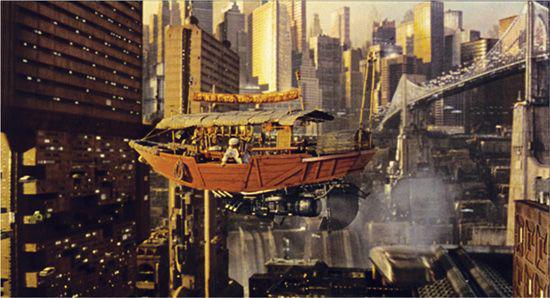
4.24
The Fifth Element
creates a collagelike city using computer graphics to join images from various sources.
In manipulating a shot’s setting, the filmmaker may use a
prop
—short for
property.
This is another term borrowed from theatrical mise-en-scene. When an object in the setting has a function within the ongoing action, we can call it a prop. Films teem with examples: the snowstorm paperweight that shatters at the beginning of
Citizen Kane,
the little girl’s balloon in
M,
the cactus rose in
The Man Who Shot Liberty Valance,
Sarah Connor’s hospital bed turned exercise machine in
Terminator 2: Judgment Day.
Comedies often use props for humorous purposes
(
4.25
).
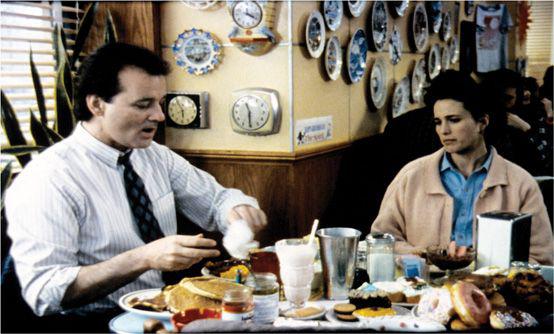
4.25 The irresponsible protagonist of
Groundhog Day
eats an enormous breakfast made up of props that dominate the foreground of the diner setting.
“The best sets are the simplest, most ‘decent’ ones; everything should contribute to the feeling of the story and anything that does not do this has no place. Reality is usually too complicated. Real locations contain too much that is extreme or contradictory and always require some simplifying: taking things away, unifying colors, etc. This strength through simplicity is much easier to achieve on a built set than in an existing location.”
— Stuart Craig, art director,
Notting Hill
Over the course of a narrative, a prop may become a motif. In Alexander Payne’s
Election,
the fussy, frustrated high-school teacher begins his day by cleaning out the faculty refrigerator
(
4.26
).
Soon afterward, he picks up hallway litter
(
4.27
).
At a major turning point in the plot, he decides to conceal a decisive ballot, which he crumples and secretly drops into a wastebasket
(
4.28
).
Payne calls this the motif of trash, “of throwing things away, since that’s in fact the climax of the film…. So we establish it early on.”
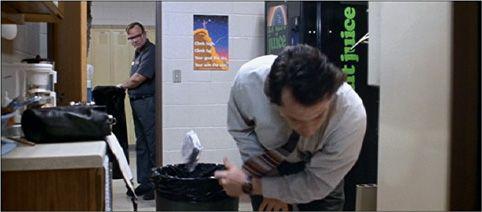
4.26 In
Election,
as he discards spoiled leftovers, the teacher is suspiciously watched by the custodian—who will play an important role in his downfall.
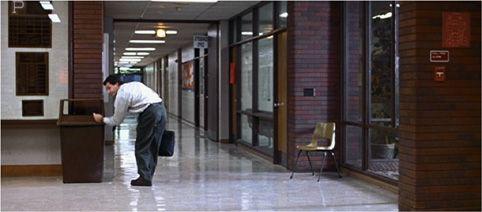
4.27 He tosses a scrap of paper into the corridor trash bin.
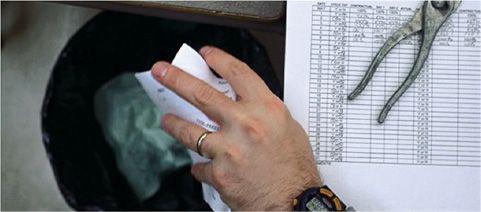
4.28 A close-up of the teacher’s hand discarding the crucial vote for student council president.
When the filmmaker uses color to create parallels among elements of setting, a color motif may become associated with several props, as in Souleymane Cissé’s
Finye
(
The Wind,
4.29
–
4.31
). In these and other scenes, the recurrent use of orange creates a cluster of nature motifs within the narrative. Later in this chapter, we shall examine in more detail how elements of setting can weave through a film to create motifs.

4.29
Finye
begins with a woman carrying an orange calabash as the wind rustles through weeds.

4.30 Later, the vengeful grandfather prepares to stalk his grandson’s persecutor by dressing in orange and making magic before a fire.
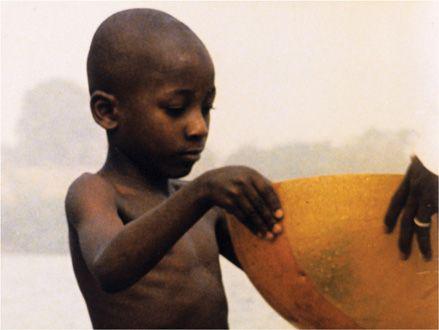
4.31 At the end, the little boy passes his bowl to someone offscreen—possibly the couple seen earlier.
Like setting, costume can have specific functions in the total film, and the range of possibilities is huge. Erich von Stroheim, for instance, was as passionately committed to authenticity of dress as of setting, and he was said to have created underwear that would instill the proper mood in his actors even though it was never to be seen in the film. In Griffith’s
The Birth of a Nation,
a poignant moment occurs when the Little Sister decorates her dress with “ermine” made of cotton dotted with spots of soot
(
4.32
).
The costume displays the poverty of the defeated Southerners at the end of the Civil War.
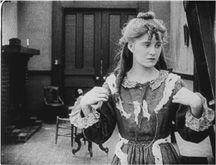
4.32 In
The Birth of a Nation,
the Little Sister realizes how shabby her dress remains despite her attempts to add festive trimming.